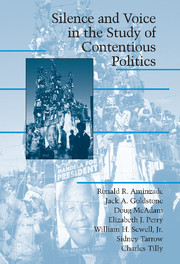Book contents
- Frontmatter
- Contents
- Preface
- 1 SILENCE AND VOICE IN THE STUDY OF CONTENTIOUS POLITICS: INTRODUCTION
- 2 EMOTIONS AND CONTENTIOUS POLITICS
- 3 SPACE IN CONTENTIOUS POLITICS
- 4 IT'S ABOUT TIME: TEMPORALITY IN THE STUDY OF SOCIAL MOVEMENTS AND REVOLUTIONS
- 5 LEADERSHIP DYNAMICS AND DYNAMICS OF CONTENTION
- 6 THE SACRED, RELIGIOUS, AND SECULAR IN CONTENTIOUS POLITICS: BLURRING BOUNDARIES
- 7 THREAT (AND OPPORTUNITY): POPULAR ACTION AND STATE RESPONSE IN THE DYNAMICS OF CONTENTIOUS ACTION
- 8 CONTENTION IN DEMOGRAPHIC AND LIFE-COURSE CONTEXT
- 9 HARMONIZING THE VOICES: THEMATIC CONTINUITY ACROSS THE CHAPTERS
- References
- Index
3 - SPACE IN CONTENTIOUS POLITICS
Published online by Cambridge University Press: 05 June 2012
- Frontmatter
- Contents
- Preface
- 1 SILENCE AND VOICE IN THE STUDY OF CONTENTIOUS POLITICS: INTRODUCTION
- 2 EMOTIONS AND CONTENTIOUS POLITICS
- 3 SPACE IN CONTENTIOUS POLITICS
- 4 IT'S ABOUT TIME: TEMPORALITY IN THE STUDY OF SOCIAL MOVEMENTS AND REVOLUTIONS
- 5 LEADERSHIP DYNAMICS AND DYNAMICS OF CONTENTION
- 6 THE SACRED, RELIGIOUS, AND SECULAR IN CONTENTIOUS POLITICS: BLURRING BOUNDARIES
- 7 THREAT (AND OPPORTUNITY): POPULAR ACTION AND STATE RESPONSE IN THE DYNAMICS OF CONTENTIOUS ACTION
- 8 CONTENTION IN DEMOGRAPHIC AND LIFE-COURSE CONTEXT
- 9 HARMONIZING THE VOICES: THEMATIC CONTINUITY ACROSS THE CHAPTERS
- References
- Index
Summary
To claim that the literature on contentious politics ignores questions of space would be inaccurate. Studies of contentious politics often provide descriptive narratives of protest actions and such accounts frequently include a description of the places where the action occurs. It is not unusual for analysts to highlight, at least in passing, spatial considerations that affect the strategies of actors or the dynamic or impact of protest events. Accounts of the 1963 Civil Rights March on Washington are likely to say something about the layout of the Mall or evoke the symbolic significance of addressing a crowd from the foot of the Lincoln Memorial (Fairclough 1995; Miller 1968; Oates 1982). Accounts of the Amritsar Massacre of 1919 will mention that the Jallianwala Bagh, where General Dyer's machine guns mowed down hundreds of Indian demonstrators, was surrounded by walls and was accessible only by very narrow gates so that protesters were trapped once the shooting began (Draper 1981). But most studies bring in spatial considerations only episodically, when they seem important either for adequate description of contentious political events or for explaining why particular events occurred or unfolded as they did. With rare exceptions, the literature has treated space as an assumed and unproblematized background, not as a constituent aspect of contentious politics that must be conceptualized explicitly and probed systematically.
Over the past few years, there has been a spate of journal articles, mostly written by either geographers or historians, that take on spatial issues directly.
- Type
- Chapter
- Information
- Silence and Voice in the Study of Contentious Politics , pp. 51 - 88Publisher: Cambridge University PressPrint publication year: 2001
- 158
- Cited by



